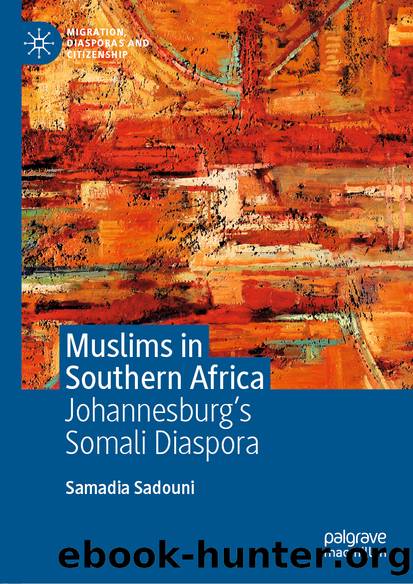Muslims in Southern Africa by Samadia Sadouni

Author:Samadia Sadouni
Language: eng
Format: epub
ISBN: 9781137467089
Publisher: Palgrave Macmillan UK
Today, the processes of innovation through migration and immigration in South Africa touch on all spheres of Somali life. In Johannesburg, they have learnt to overcome various barriers, such as those created by gender and clan identities, which would have been more difficult to cross at home. For example, womenâs journeys represent an agency for change within the Somali transnational space. In this specific situation, gender relations are often under great pressure and may consequently shift. Gender is therefore a factor of differentiation among Somali migrants. How did Somali women become transnational migrants? Womenâs mobility is first enabled by the institution of Islamic marriage because travelling alone as a single woman in unsafe environments is generally considered morally reprehensible. Women often married in transitory places like the UNHCR refugee camps in Kenya , or once settled in South Africa. For men and women alike, social and religious status is granted through marriage, but for women it is far more important.
Being female can also serve women on their migrant trajectories. Being pregnant and giving birth in Europe can guarantee a longer stay as refugees. This is a strategy often used by female refugees. One such example was referred to during an interview with a married woman with children who lived in Johannesburg. She decided to go to Europe while she was pregnant in order to have a better chance for resettlement for herself and her family. Once there, she gave birth and was thus entitled to reside legally in the country and benefit from the welfare state. The travelling woman also has social consequences for motherhood and in the family circle as women gain confidence after proving to themselves that they can survive their migratory journeys . Families, therefore, become institutions of the transnational migrant space (Herrea Lima 2001; Baldassar and Merla 2014; Hondagneu-Sotelo and Avila 1997).
Gender relations are under great pressure in the context of immigration and are transformed, as evidenced by the number of divorces and single-parent families in Mayfair . The ideology of the male breadwinner has been challenged by Somali women who have become the main income earners in their families while their husbands are unemployed. These tensions sometimes result in men leaving their wives and children without any address. Women in professional employment can provide for their children. Those without financial resources rely on Somali solidarity or aid from South African Muslim organisations. Most of the women interviewed in Mayfair were divorced for the second time: their husbands had either left or remarried. Islamic marriages, but also divorces, are central in gender relationships.
Other Somali women have gained a measure of independence through involvement in small-business ventures. They work as hawkers, selling vegetables on the streets of Mayfair , or they own shops in the Amal mall , sometimes in partnership with Somali men. This increases the financial independence of women in the household and in the community. Some women even venture into African townships , like those near Kimberley , in order to earn better incomes, and in the process learn to speak a South African language.
Download
This site does not store any files on its server. We only index and link to content provided by other sites. Please contact the content providers to delete copyright contents if any and email us, we'll remove relevant links or contents immediately.
What's Done in Darkness by Kayla Perrin(25500)
Shot Through the Heart: DI Grace Fisher 2 by Isabelle Grey(18220)
Shot Through the Heart by Mercy Celeste(18160)
The Fifty Shades Trilogy & Grey by E L James(17775)
The 3rd Cycle of the Betrayed Series Collection: Extremely Controversial Historical Thrillers (Betrayed Series Boxed set) by McCray Carolyn(13189)
The Subtle Art of Not Giving a F*ck by Mark Manson(12912)
Scorched Earth by Nick Kyme(11832)
Stepbrother Stories 2 - 21 Taboo Story Collection (Brother Sister Stepbrother Stepsister Taboo Pseudo Incest Family Virgin Creampie Pregnant Forced Pregnancy Breeding) by Roxi Harding(11040)
Drei Generationen auf dem Jakobsweg by Stein Pia(10217)
Suna by Ziefle Pia(10186)
Scythe by Neal Shusterman(9262)
International Relations from the Global South; Worlds of Difference; First Edition by Arlene B. Tickner & Karen Smith(8608)
Successful Proposal Strategies for Small Businesses: Using Knowledge Management ot Win Govenment, Private Sector, and International Contracts 3rd Edition by Robert Frey(8419)
This is Going to Hurt by Adam Kay(7695)
Dirty Filthy Fix: A Fixed Trilogy Novella by Laurelin Paige(6453)
He Loves Me...KNOT by RC Boldt(5804)
How to Make Love to a Negro Without Getting Tired by Dany LaFerrière(5378)
Interdimensional Brothel by F4U(5304)
Thankful For Her by Alexa Riley(5161)
